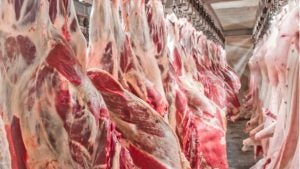Cattle with liver abscesses can experience health problems and reduced growth and feed efficiency. However, cattle with liver abscesses don’t show clinical signs and are generally identified too late — at harvest. The economic losses associated with this condition in cattle can be as high as 400 million dollars annually.
A collaborative effort between scientists from the U.S. Department of Agriculture’s Agricultural Research Service, Texas Tech University, Kansas State University, and West Texas A&M University work on reliable and repeatable liver abscess models to learn the triggers for this costly condition in cattle that not only negatively impacts animal well-being but also causes liver condemnations and may lead to increased carcass trimming and an overall decrease in profitability.
The first successful model study, recently published in the Journal of Animal Science, is part of a series of studies conducted at the USDA-ARS Livestock Issues Research Unit in Lubbock, Texas. These studies aim to find solutions to a problem of concern for animal well-being that is costing the industry millions of dollars.

“After decades of studies, researchers haven’t found an accurate way to predict nor diagnose liver abscesses, because of the complexity of the disease,” said Rand Broadway, a research scientist with the Livestock Issues Research Unit. “Our study is a huge collaborative effort between USDA and academic partners to develop a liver abscess model in cattle that can help us better understand how liver abscess formation begins. We are constantly learning about the causes and development of these abscesses.”
This model consistently showed a 50 percent prevalence, which is important for researchers to study liver abscess development and prevention strategies, particularly in calves entering the beef supply chain from dairy origin. In addition, the model continues to be improved to mimic “real-world” disease etiology while examining the physiological changes in the animal to better understand the root causes of the disease.
Currently, the primary treatment to prevent liver abscesses in cattle has been in-feed antibiotics. However, the general public has become more skeptical of antibiotics, and alternatives are being sought.
“We are trying to ensure this model is effective and applicable to test non-antibiotic interventions in the future,” added Broadway. “We seek to use the knowledge gained from these models to develop different alternative interventions, such as nutrition management strategies.”
In the study, scientists work with dairy and ‘beef-dairy’ cross steers, the population of cattle that most commonly suffer from this infection. They tested two diets (a high grain-based and forage-based) and three bacteria commonly found in liver abscesses (Fusobacterium necrophorum subsp. necrophorum, Trueperella pyogenes, and Salmonella enterica serovar). The results from the high-grain diet model were more reliable, leading scientists to focus more on this model.
Most people associate liver abscesses in cattle with a high-energy diet. The theory is that when cattle are fed elevated grain levels, highly fermentable starch in the rumen is rapidly fermented by bacteria, causing a drop in rumen pH. This acidity causes damage to the rumen lining, allowing bacteria to travel into the blood, reaching the liver and other organs where they can cause infection. However, it is still unknown with accuracy the exact route that these bacteria take to cause infection or injury to the liver.
Scientists discovered that the bacteria associated with liver abscesses in cattle may not always originate from the rumen. An alternative route may be bacterial travel from the lower gastrointestinal tract. The research showed that in some cases, when these bacteria were not detected in the acidic rumen environment caused by a high-grain diet, no liver abscesses were detected. However, when scientists introduced bacteria directly to the rumen, they observed the formation of liver abscesses and were able to isolate the bacteria from the infected sites.
The study confirms that an acidotic diet, combined with bacterial inoculation in the rumen, can be used as a model to induce liver abscesses. However, further research is being conducted at USDA to determine the consistency of the model before it can be used to evaluate new interventions to prevent this complex infection.


